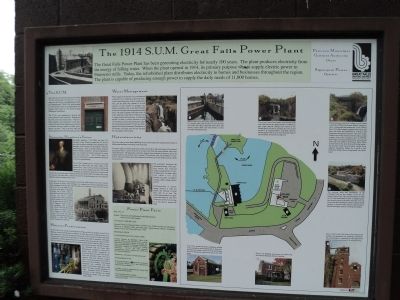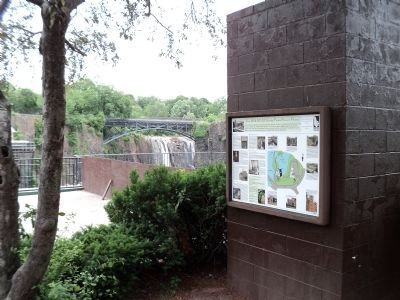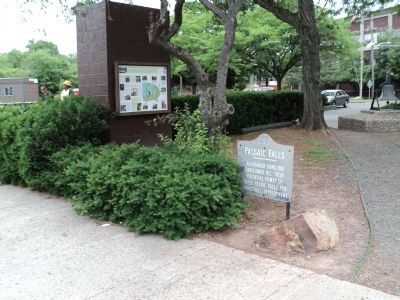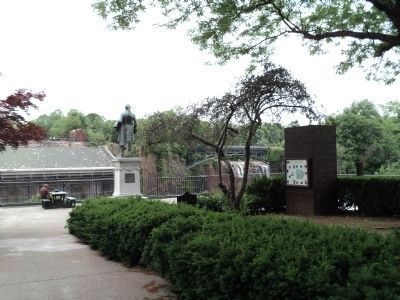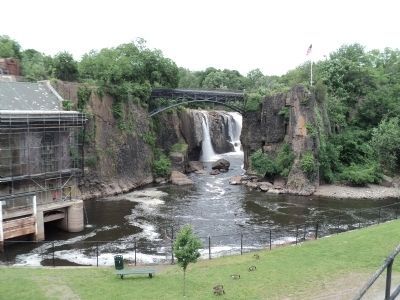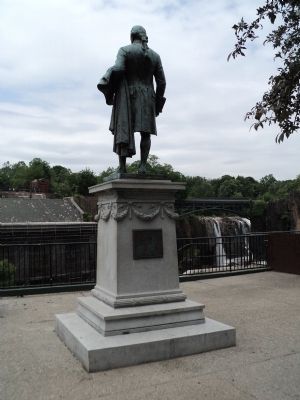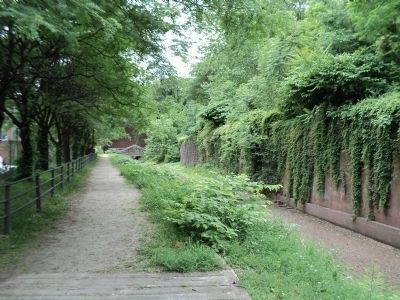Paterson in Passaic County, New Jersey — The American Northeast (Mid-Atlantic)
The 1914 S.U.M. Great Falls Power Plant
The Great Falls Power Plant has been generating electricity for nearly 100 years. The plant produces electricity from the energy of falling water. When the plant opened in 1914, its primary purpose was to supply electric power to Patersonís mills. Today, the refurbished plant distributes electricity to homes and businesses throughout the region. The plant is capable of producing enough power to supply the daily needs of 11,000 homes.
The S.U.M.
Above the door of the power plant are the initials “S.U.M.” and the dates 1791 and 1914. S.U.M. stands for the Society for Establishing Usefull (sic) Manufacturers. The S.U.M. as an organization was founded much earlier in 1791 during George Washingtonís presidency.
The S.U.M. was established to develop the power potential of the Great Falls. Waterpower has been used since ancient times. Patersonís mills originally used waterpower to turn individual waterwheels that supplied power directly to machines through systems of shafts, gears, pulleys, and belts. Only in the late 1800ís did electric generation become technically possible.
Alexander Hamiltonís Vision
Alexander Hamilton (1754-1804), the first U.S. Secretary of the Treasury, created the S.U.M. His goal was to achieve economic and industrial independence from Europe by developing American manufacturing. Prior to the Revolution, America had few domestic industries. The key to Hamiltonís plan was a system of factories powered by water from the Great Falls. The S.U.M. ranks as Americaís first effort to create a planned community devoted to manufacturing.
The S.U.M.ís charter gave it control of the lands around the Great Falls and water rights to the Passaic River. The S.U.M. soon discovered that the water was its most valuable asset. By 1838 it had completed an impressive three-level, power-canal or raceway system that exists in Paterson to this day. By the 1850ís, the factory sites along the raceway had been filled. Paterson became the manufacturing city envisioned by Hamilton and the founders of the S.U.M.
In the early 1910ís, the S.U.M. decided to convert the mills along its raceway to electric power because of chronic water shortages. As northern New Jerseyís population grew, water companies formed to take water from the river. Sometimes water levels fell so low that the S.U.M. was unable to provide water to the mills. To meet this challenge, the S.U.M. joined in agreement with other users to better manage their water supply. Eventually, the S.U.M. fell under the financial control of a trust company that decided that the water used to power Patersonís mills would be more profitably sold as potable water. The S.U.M. built the electric power plant as a means to end the millís reliance on water from the raceway. The S.U.M. also built an auxiliary coal-fueled steam plant (demolished in 1960) that supplied power when the river ran low.
Historic Preservation
In 1945, the S.U.M. sold the Great Falls Power Plant and all of its property to the City of Paterson, which leased the plant to PSE&G. In 1969, the plant was shut down due to its age, modest size and need for upgrades. During the 1970ís, a group of citizens interested in preservation looked into the possibility of returning the plant to operation. Through a combination of federal grants and private investment, they came up with a plan. In 1980, the City of Paterson established the Paterson Municipal Utilities Authority (MUA) to own and operate the plant. The MUA eventually partnered with the Great Falls Hydroelectric Company to raise $14.5 million from private investments; no local tax dollars were used. The old turbines and generators from 1914 were replaced with more efficient, modern units. One of the original units was left in place as a historic display. The modern equipment was installed with little impact on the historic appearance of the plant. The plant resumed operation in 1986. Algonquin Power of Toronto, a specialist in the operation of smaller hydroelectric plants, took over operations in 2000.
Water Management
Water supply in the Passaic is not constant and continues to be a challenge at the Great Falls. In late winter and spring, water is usually plentiful, and the plant may operate to its full capacity. In the late summer or droughts, the Passaic sometimes runs so low that the plant doesnít have enough water to operate and shuts down. The plant competes with other users of water, especially water drawn to fill reservoirs to supply homes and businesses. A minimum amount of water is always allowed to spill over the falls for scenic enjoyment and to maintain environmental quality for fish and other aquatic life living downstream. The plant has a fish bypass, an escape route for any fish that become trapped in the forebay.
Hydroelectricity
The power plant is more than a building. Itís an entire system for capturing the energy in falling water and then converting it into electricity.
The power plant is situated at the base of the Great Falls to take advantage of the natural geography. Water is drawn from the river above the falls and enters buried steel tubes called penstocks. The penstocks, which are angled down at about 45 degrees, direct the rushing water to one of three active turbines. The turbines look like propellers or pinwheels. The water rapidly spins the turbines, the turbines spin steel shafts, and the shafts turn generators.
The generators transform the mechanical
energy using properties of electromagnetism. A wound copper wire, called a coil, spins between the poles of magnets creating a high-voltage electric current.
Hydroelectricity is “green” energy because it does not require the burning of fossil fuels, like oil or coal. The power plant produces no significant waste material. The water is returned to the river as clean as it was when it entered the plant.
Power Plant Facts
Builder: The Society for Establishing Usefull Manufactures
† † † † † † † † † John H. Cook, chief engineer
Cost to Build: ~$500,000 (1914)
Original Turbine & Generator Data (1914-69): Four, 2,400-volt 60-cycle alternators driven by S. Morgan Smith, horizontal-shaft, double-runner turbines. Generating capacity of 6.551 hp, Turbine efficiency ~ 70%.
Refurbished: 1984-86
Cost of Refurbishment: $14.5 million (1986)
Current Turbine & Generator Data (1987-present): Three, 4,160-volt, 60-cycle, vertical, direct-drive generators driven by Kaplan turbines with adjustable wicket gates and blades. Generating capacity of 10,950 kw. Turbine efficiency ~ 92.1%. The 1986 upgrade increased the electric capacity by 125% over the original equipment.
Plant flow: 2,130 cubic ft. of water per second.
Net Head Rated: 67.9 ft.
The Great Falls Raceway and Power System is a National Historic Civil and Mechanical Engineering Landmark.
In 2009, Congress established the Great Falls National Historical Park.
For tour information, call the Great Falls Historic District Cultural Center at (973) 279-9587.
[ Sidebar: ]
A map of the Great Falls and S.U.M. area indicates several sites with a picture and description of each:
1) Water is drawn into the power plant from the river in a channel called the forebay cut into the hard rock of the cliff. Gates control the waterís flow, and screens capture debris and trash before it enters steel tubes called penstocks.
2) The Great Falls of the Passaic were formed at the end of the last ice age, approximately 13,000 years ago, when glaciers changed the course of the Passaic River. As the ice receded, the river carved out the 77-ft-high and 280-ft-wide falls. The rock underlying the falls is an erosion-resistant ridge of ancient basalt, also known as trap rock.
3) The picturesque steel-arch bridge over the chasm was built in 1888 by the Passaic Water Company to carry a water pipe and pedestrians. From 1849 to after 1913, the company pumped water from just above the Falls and distributed it to homes and businesses throughout Paterson. The stone walls, visible in low water at the head of the chasm, are the remains of the water companyís dam. In 1983 the arch bridge was closed to
pedestrians, and a second water pipe was added by the Passaic Valley Water Commission to the deck of the arch bridge replacing the pipe which was previously carried by an adjacent suspension bridge. As a result, a new pedestrian bridge (shown foreground) was substituted.
4) The concrete walls and foundations of the Overlook Park are the remains of the S.U.M. Stream Power Plant. The coal-fired plant was built in 1915 and demolished in 1960. It supplied auxiliary electric power to the mills when the river was too low for the hydroelectric plant to operate at full capacity. It also provided steam for processing in the mills through a system of underground pipes.
5) The S.U.M. Great Falls Power Plant houses the turbines and generators for producing electricity. The power plant is connected to the upper-level forebay and gatehouse by an 85-ft-tall stair tower.
6) The S.U.M. Building now houses city offices and the Paterson Municipal Utilities Authority.
7) The S.U.M. gatehouse houses equipment related to the monitoring and transmission of electricity from the power plant, as well as work and storage space for operations related to the gates and trash racks.
Topics. This historical marker is listed in this topic list: Industry & Commerce. A significant historical year for this entry is 1914.
Location. 40° 54.909′ N,
74° 10.812′ W. Marker is in Paterson, New Jersey, in Passaic County. Marker can be reached from the intersection of McBride Avenue and Spruce Street, on the left when traveling east. Marker is located in Haines Overlook Park. Touch for map. Marker is in this post office area: Paterson NJ 07501, United States of America. Touch for directions.
Other nearby markers. At least 8 other markers are within walking distance of this marker. Great Falls of Paterson on the Passaic (here, next to this marker); Captain Eric M. Graupe (a few steps from this marker); Passaic Falls (a few steps from this marker); Great Falls of the Passaic/S.U.M. Historic District (a few steps from this marker); The Allied Textile Printing Site (within shouting distance of this marker); Overlook Park (within shouting distance of this marker); Harry B. Haines Memorial Park (within shouting distance of this marker); Great Falls Hydroelectric Station (within shouting distance of this marker). Touch for a list and map of all markers in Paterson.
Credits. This page was last revised on June 16, 2016. It was originally submitted on June 6, 2011, by Bill Coughlin of Woodland Park, New Jersey. This page has been viewed 1,904 times since then and 107 times this year. Photos: 1, 2, 3, 4, 5, 6, 7. submitted on June 6, 2011, by Bill Coughlin of Woodland Park, New Jersey.
